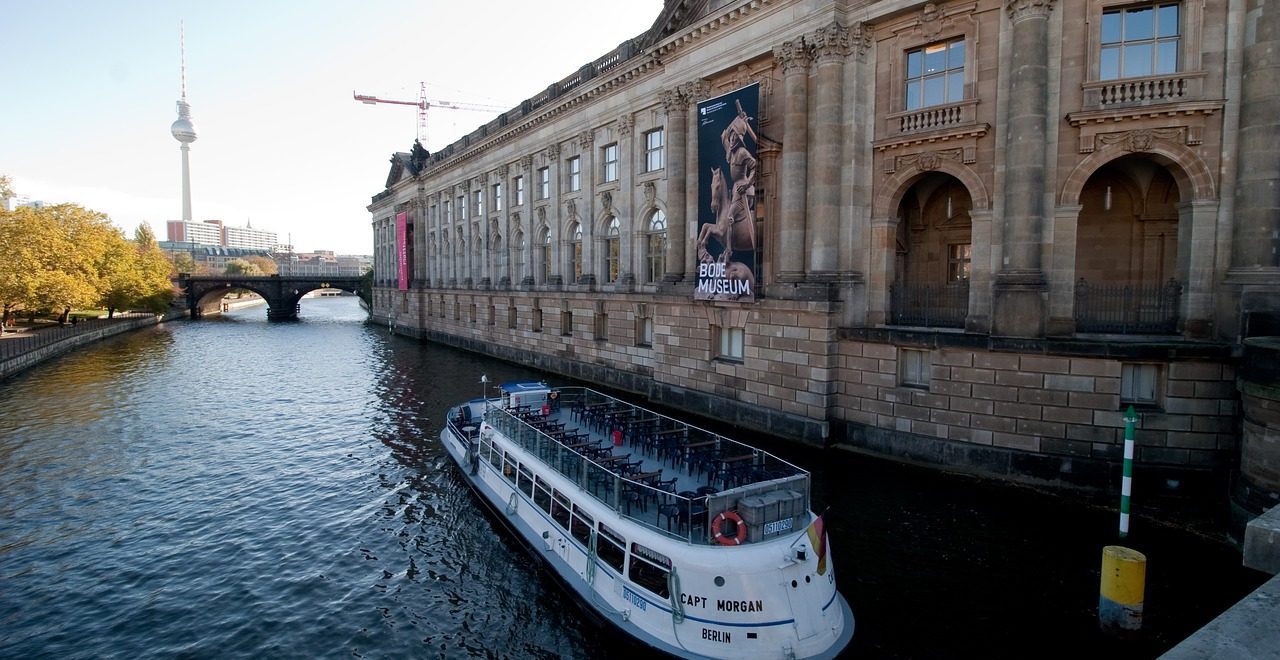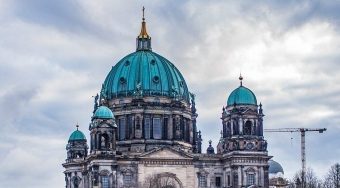Whilst Berlin is known to be the cultural capital of Europe and hosts a vast number of museums around the entire city, some of the most famous and impressive are all located in this single location. An island on the Spree river in the Mitte district of town holds these places of local, national and global culture within a foray of stately and opulent buildings. As such, Museum Island is now a listed UNESCO world heritage site, and it is worth visiting for the buildings alone. The island also has grounds of beautiful greenery amongst the buildings. It is recommended to dedicate at least a day to the vast amount of exhibitions available throughout the museums here. Also purchasing tickets ahead of time can avoid the long queues that are common in this popular area of town. If you’re visiting on a Saturday, there is often a local arts and crafts market that has many unique and quirky items for sale.
The Pergamon Museum
One of the best-known museums of the whole city, the Pergamon was constructed between 1910-1930 and is the housing place of many artefacts from the ancient Roman and Hellenistic world, as well as Asia Minor and Anatolia. It became a requirement as many German archaeologists were bringing back lots of findings from the area, including Heinrich Schliemann’s finding of the Treasure of Priam- the first time evidence for the city of Troy was discovered. The layout comprises of three major sections: Antiquity, the Middle East, and Islamic Art. It is one of the largest museums in the country and attracts over 1 million tourists yearly. Major exhibitions include the Mshatta Facade, the Ishtar Gate of Babylon, the Market Gate of Miletus and of course the Pergamon Altar, from which the museum takes its name. This is, however, under reconstruction works until the end of 2019.
Der Pergamonaltar im Pergamonmuseum. © Staatliche Museen zu Berlin, Antikensammlung / Johannes Laurentius
Posted by Pergamonmuseum on Thursday, February 21, 2019
The Bode Museum
The signature sight of the island, seated next to the river with its iconic domed roof, the Bode Museum was completed in 1906 by renowned architect Ernst von Ihne. Originally named after King Friedrich, the name changed to its original curator, Wilhelm von Bode, in 1954. A magnificent sight at both day and night, the interior exhibitions focus largely on a sculpture of various periods. It features masterpieces such as: ‘Tarquinius and Lucretia’ by Pietro Tacca, Donatello’s ‘Pazzi Madonna’, Canova’s ‘Dancer’ and the late Baroque works of German sculptors Riemenschneider and Günther. Eras covered are the Gothic and Byzantine, Renaissance, Baroque, Middle Ages, and Christian Orient. There is also one of the world’s largest numismatic collections held here. The museum has been described as allowing “Europe to read it’s history- aesthetic and religious, intellectual and political- in three-dimensional form.”
© Staatliche Museen zu Berlin / Bernd Weingart
Posted by Bode-Museum on Friday, August 17, 2018
The Altes Museum
German for ‘Old Museum’, it houses the antique collection from the Berlin State Museums. Built in the 1820s, it is known for being a stunning example of the neoclassical architectural style, and the high point of architect Karl Friedrich Schinkel’s career. It was originally built to house the art collection of the Prussian Royal Family, but the turn of the 20th century saw the change to antiquities. Many works from ancient Rome and Greece are here, including bronze and marble statues, urns, ivory carvings, ceramics, precious stones, jewelry, and vases. It also holds the largest collection of Etruscan art outside of Italy. Special exhibitions are displayed on the second floor.
Heute Abend ist es so weit – die Sonderausstellung FLEISCH eröffnet um 19 Uhr.Wir freuen uns auf euch!
Posted by Altes Museum on Thursday, May 31, 2018
The Neues Museum
Originally this museum was built between 1843-1855, to the north of the Altes Museum. During the Nazi government period, however, it was closed and later heavily damaged during the bombardment of the city. The rebuilding was overseen by architect David Chipperfield and it reopened in October of 2009. The building, both its exterior and interior, are of neoclassical style and it played an important role in the development of building technology. There are many exhibits dating back to Ancient Egypt here, as well as prehistoric and early historic artifacts. You will find sarcophagi and example of tomb walls, decorated in sophisticated hieroglyphs, as well the papyrus collection and the Library of Antiquity. The crowning feature is the ‘Bust of Queen Nefertiti’, a sculpture which dates back to 1300 BC.
© Staatliche Museen zu Berlin, Foto: Achim Kleuker
Posted by Neues Museum on Thursday, March 22, 2012
The Alte Nationalgalerie
The Old National Gallery was built in 1876 by Johann Heinrich Strack as an elevated temple for German and European art. It was the dream of King Friedrich Wilhelm IV to be a sanctuary for art and science. Here the collection holds fine art from many of Europe’s greats, particularly from the Romanticism, Early Modernism, and Impressionism movements. The works of Monet, Manet, Cezanne, Schinkel, Renoir, and Caspar David Friedrich, to name a few, can be found here. It also has one of the world’s largest collections of 19th-century German sculpture and paintings here.
Frontansicht der Alten Nationalgalerie mit dem Giebelfries und dem Säulengang.© Staatliche Museen zu Berlin / Stephanie von Becker
Posted by Alte Nationalgalerie on Friday, March 22, 2019
The Humboldt Forum
Set to be a large scale museum in the reconstructed Berlin Palace, the doors to the Humboldt Forum will be open later on in 2019. It will incorporate the Ethnological Museum of Berlin, as well as the Museum of Asian Art, with its roots in the Ancient Prussian Arts Chamber that was once also housed in the Palace. There will also be two restaurants, a theatre, a cinema and an auditorium as part of the forum. The management committee is chaired by Neil Macgregor, the former director of the British Museum. Macgregor hopes to make the Humboldt Forum the equivalent of the British Museum in Berlin.
Posted by Humboldt Forum on Tuesday, November 6, 2018




